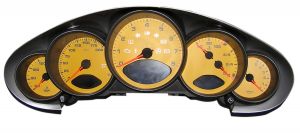 Lately, there has been a lot of buzz around GM’s bounce back from the brink of death and the future of its Chevy Volt. This year the focus has shifted somewhat to the fruits borne by research and development departments of companies like Volvo and Google. Both recently showed off innovations that take some off the pressure of drivers, hopefully increasing safety on the roads.
Lately, there has been a lot of buzz around GM’s bounce back from the brink of death and the future of its Chevy Volt. This year the focus has shifted somewhat to the fruits borne by research and development departments of companies like Volvo and Google. Both recently showed off innovations that take some off the pressure of drivers, hopefully increasing safety on the roads.
Volvo was one of seven companies, along with the European Commission, to fund research in the SATRE project. SATRE stands for Safe Road Trains for the Environment, and refers to a train of semi-automated cars controlled through sensors and cameras by a lead driver. In January 2012, SATRE successfully conducted its first field test of a “platoon”, in which a larger lead vehicle controlled a line of cars behind it as it drove along the motorway. The SARTRE project claims that the semi-automated trains of cars could save up to 20% in energy expenditures per car. The train could potentially reduce congestion and allow drivers to participate in activities that are usually deemed dangerous when behind the wheel, such as reading, eating, and playing on media devices. When drivers choose to leave the train they send a signal to the lead car, which then provides a space gap for the car to exit. SATRE plans for the trains to use existing infrastructure and consumer vehicles for the project to make it easier to expand. The goal of the project is firstly to reduce traffic congestion and energy costs. Secondly, it aims to increase safety on freeways, as driver error is responsible for 87% of all accidents and the project decreases the need for the driver to constantly stay alert.
Volvo has also promoted automated technology within its own company. In March 2012, it showed the Volvo V40 at the Geneva Motor Show. The car has sensors in its grill that detects the distance of objects from the front of the car, and is meant to prevent crashes with pedestrians. If the sensors predicts a possible impact it beeps an alarm to the driver. If the driver does not respond, the car automatically brakes. In the unfortunate event that the Volvo does hit a pedestrian with its front bumper, a pedestrian air bag inflates from the hood and covers one third of the windshield to limit head injuries to the pedestrian. The hood also lifts somewhat to increase the hood’s absorption of force and decrease injuries. This type of airbag works well in sedans, and the company AutoLiv has tested front edge airbags and bumper airbags on SUV’s, which impact pedestrians’ abdomens more than their head. The study Injury Mitigation in SUV to Pedestrian Impacts found that these airbags reduced injuries to the upper abdomen by more than a third and in some instances by half.
Google is also looking for technologies that make driving safer and more convenient. It publicly debuted its self-driving car in March 2011, but attracted a lot of attention last month when the Los Angeles Times reported that one of its cars took the blind Steve Mahon for a ride. The car chauffeured Mr. Mahon through city streets to grab a bite at Taco Bell and pick up his dry cleaning. The self-driving car could make driving safer on both urban roads and highways by automating the route. Nevada was the first state to legalize self-driving cars on its roadways in February 2012.
The impressive projects from Volvo, Google, and other companies are still in small scale testing. Meanwhile, according to the National Highway Traffic and Safety Administration, 32,885 people were killed in motor vehicle crashes in 2010, most of which involved some form of human error. If you have been injured in an accident, you may want to consult with an attorney to see if you can recover for medical expenses and pain and suffering.
Greg Brod is an experienced personal injury lawyer practicing in the San Francisco Bay Area and beyond. Contact us today by phone or online for a free consultation.
 San Francisco Injury Lawyer Blog
San Francisco Injury Lawyer Blog

